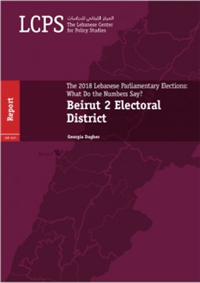Beirut 2: What’s in the Ballot Box? Unpacking the 2018 Elections

In the Lebanese parliamentary elections of 2018, the electoral district of Beirut 2 saw one of the lowest participation rates across the country. Nevertheless, there were significant variations across confessional groups: Muslim communities were significantly more likely to vote compared to their Christian counterparts. Sectarian parties were successful in mobilizing their target constituents. The majority of Sunni voters chose the Future Movement, with AlAhbash and the National Dialogue Party—who each won a Sunni seat—receiving most of the remaining of the Sunni vote. The majority of Shia voters voted for Hezbollah, followed by Amal, and the majority of Druze voters cast their ballot for the Progressive Socialist Party. Among Christian groups, the candidate from the Free Patriotic Movement received a high share of votes; however, their votes were highly fragmented between Christian candidates from other affiliations. In line with this, an overwhelming majority of voters in Beirut 2 cast their preferential vote for a candidate from their same sect. Even those who voted for independent candidates running on the Kelna Beirut and ‘Independent Beirutis’ lists showed a confessional bias. Beirut 2 was the district with the highest number of women candidates, with all electoral lists except one having at least one woman candidate. While most women received very few votes, women candidates tended to perform best among their sectarian communities. Moreover, women voters were significantly more likely to vote for women candidates, with nearly all these candidates receiving a higher number of votes from women than men.
Georgia Dagher
former researcher at the Lebanese Center for Policy Studies (LCPS)
 In the Lebanese parliamentary elections of 2018, the electoral district of Beirut 2 saw one of the lowest participation rates across the country. Nevertheless, there were significant variations across confessional groups: Muslim communities were significantly more likely to vote compared to their Christian counterparts. Sectarian parties were successful in mobilizing their target constituents. The majority of Sunni voters chose the Future Movement, with AlAhbash and the National Dialogue Party—who each won a Sunni seat—receiving most of the remaining of the Sunni vote. The majority of Shia voters voted for Hezbollah, followed by Amal, and the majority of Druze voters cast their ballot for the Progressive Socialist Party. Among Christian groups, the candidate from the Free Patriotic Movement received a high share of votes; however, their votes were highly fragmented between Christian candidates from other affiliations. In line with this, an overwhelming majority of voters in Beirut 2 cast their preferential vote for a candidate from their same sect. Even those who voted for independent candidates running on the Kelna Beirut and ‘Independent Beirutis’ lists showed a confessional bias. Beirut 2 was the district with the highest number of women candidates, with all electoral lists except one having at least one woman candidate. While most women received very few votes, women candidates tended to perform best among their sectarian communities. Moreover, women voters were significantly more likely to vote for women candidates, with nearly all these candidates receiving a higher number of votes from women than men.Georgia Dagher former researcher at the Lebanese Center for Policy Studies (LCPS)
In the Lebanese parliamentary elections of 2018, the electoral district of Beirut 2 saw one of the lowest participation rates across the country. Nevertheless, there were significant variations across confessional groups: Muslim communities were significantly more likely to vote compared to their Christian counterparts. Sectarian parties were successful in mobilizing their target constituents. The majority of Sunni voters chose the Future Movement, with AlAhbash and the National Dialogue Party—who each won a Sunni seat—receiving most of the remaining of the Sunni vote. The majority of Shia voters voted for Hezbollah, followed by Amal, and the majority of Druze voters cast their ballot for the Progressive Socialist Party. Among Christian groups, the candidate from the Free Patriotic Movement received a high share of votes; however, their votes were highly fragmented between Christian candidates from other affiliations. In line with this, an overwhelming majority of voters in Beirut 2 cast their preferential vote for a candidate from their same sect. Even those who voted for independent candidates running on the Kelna Beirut and ‘Independent Beirutis’ lists showed a confessional bias. Beirut 2 was the district with the highest number of women candidates, with all electoral lists except one having at least one woman candidate. While most women received very few votes, women candidates tended to perform best among their sectarian communities. Moreover, women voters were significantly more likely to vote for women candidates, with nearly all these candidates receiving a higher number of votes from women than men.Georgia Dagher former researcher at the Lebanese Center for Policy Studies (LCPS)